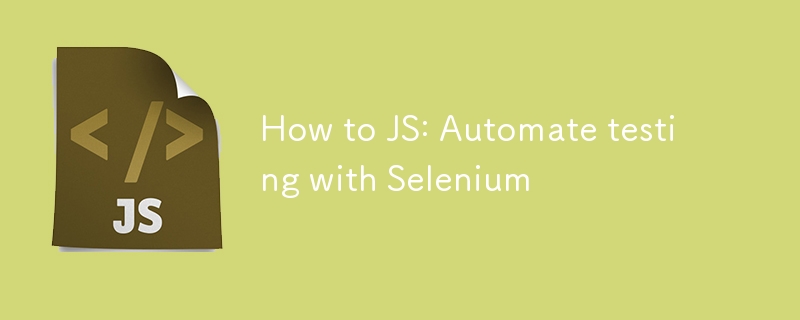

Automated browser testing is a must for any web developer to ensure their applications function correctly. In this post, we'll walk through setting up Selenium with JavaScript to automate a simple browser task: opening a webpage and clicking a button.
To follow along, you’ll need:
First, create a new folder for your project. Open your terminal and run:
mkdir selenium-test cd selenium-test
Next, initialize a new Node.js project:
npm init -y
This command generates a package.json file that keeps track of your project’s dependencies.
We’ll use npm to install Selenium WebDriver and ChromeDriver:
npm install selenium-webdriver chromedriver --save
These packages provide the necessary libraries and tools to automate Chrome with Selenium.
Create a new file named test.js in your project folder. This script will open a webpage, wait for a button to become clickable, and then click it.
const { Builder, By, until } = require('selenium-webdriver');
const chrome = require('selenium-webdriver/chrome');
// Helper function to pause the script
function sleep(ms) {
return new Promise(resolve => setTimeout(resolve, ms));
}
async function runTest() {
// Configure Chrome to suppress unwanted prompts
let options = new chrome.Options();
options.addArguments('--no-default-browser-check', '--no-first-run', '--disable-default-apps', '--disable-infobars');
let driver = await new Builder()
.forBrowser('chrome')
.setChromeOptions(options)
.build();
try {
// Open the target webpage
await driver.get('https://example.com'); // Change this URL to the site you want to test
// Wait for an element to load
await driver.wait(until.elementLocated(By.className('sample-class')), 10000);
console.log('Found element with class "sample-class".');
// Generic wait for 6 seconds to handle any dynamic content
await sleep(6000);
// Wait for the button to be clickable
await driver.wait(until.elementLocated(By.id('sample-button')), 10000);
// Re-locate the button to ensure it’s still in the DOM
let button = await driver.findElement(By.id('sample-button'));
console.log('Button located:', button);
// Click the button
await button.click();
console.log('Button clicked successfully.');
// Wait for the next page or action to load
await driver.wait(until.urlContains('new-page'), 10000);
console.log('Navigation to new page was successful.');
} catch (error) {
console.error('Error during the test:', error);
} finally {
// Always close the browser
await driver.quit();
}
}
runTest();
To execute your script, run:
node test.js
Chrome will open and perform the actions defined in your script. Watch the console for logs indicating each step's progress.
You now have a basic setup for automated browser testing using Selenium and JavaScript. This setup can be easily expanded to include more complex interactions, checks, and validation steps.
Remember to keep your drivers updated to match your browser versions and consider using a headless mode for CI/CD environments.
If you want to host it in Azure check out my other post: https://dev.to/iamrule/how-to-azure-host-a-selenium-javascript-node-application-in-azure-and-send-email-notifications-on-failures-2aio
Happy testing!
The above is the detailed content of How to JS: Automate testing with Selenium. For more information, please follow other related articles on the PHP Chinese website!




